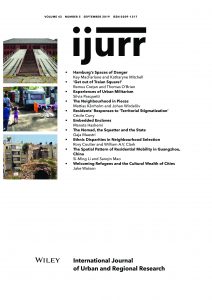A key question in urban sociology is how people interpret the urban environment. At a time when cities are increasingly militarized, this question is particularly important for understanding how militarism impacts urban life. However, urban sociologists have not addressed how people experience militarized environments. This article turns to this question by considering the case of Lydda‐Lod, an Israeli city that has been demographically and physically transformed by war, displacement and securitization. Drawing on Wacquant’s sociology of spatial stigma and adding insights from works on emotions in (post‐)conflict cities, I examine how poor Palestinians think and feel about the surveilled districts where they live within the city’s broader landscape of ruins. I show how the Israeli military, security and policing agencies have collectively produced spatial stigmatization of these districts. I discuss how Palestinians respond to this spatial stigma by attaching a sense of worthlessness to their districts. However, this reproduction of spatial stigma is punctuated by expressions of care for the built environment and by a desire to revalorize collective Palestinian life in the city. I conclude by discussing how a perspective on militarized cities focused on everyday responses to militarism and attentive to marginalities enriches urban sociology and urban studies more generally.

